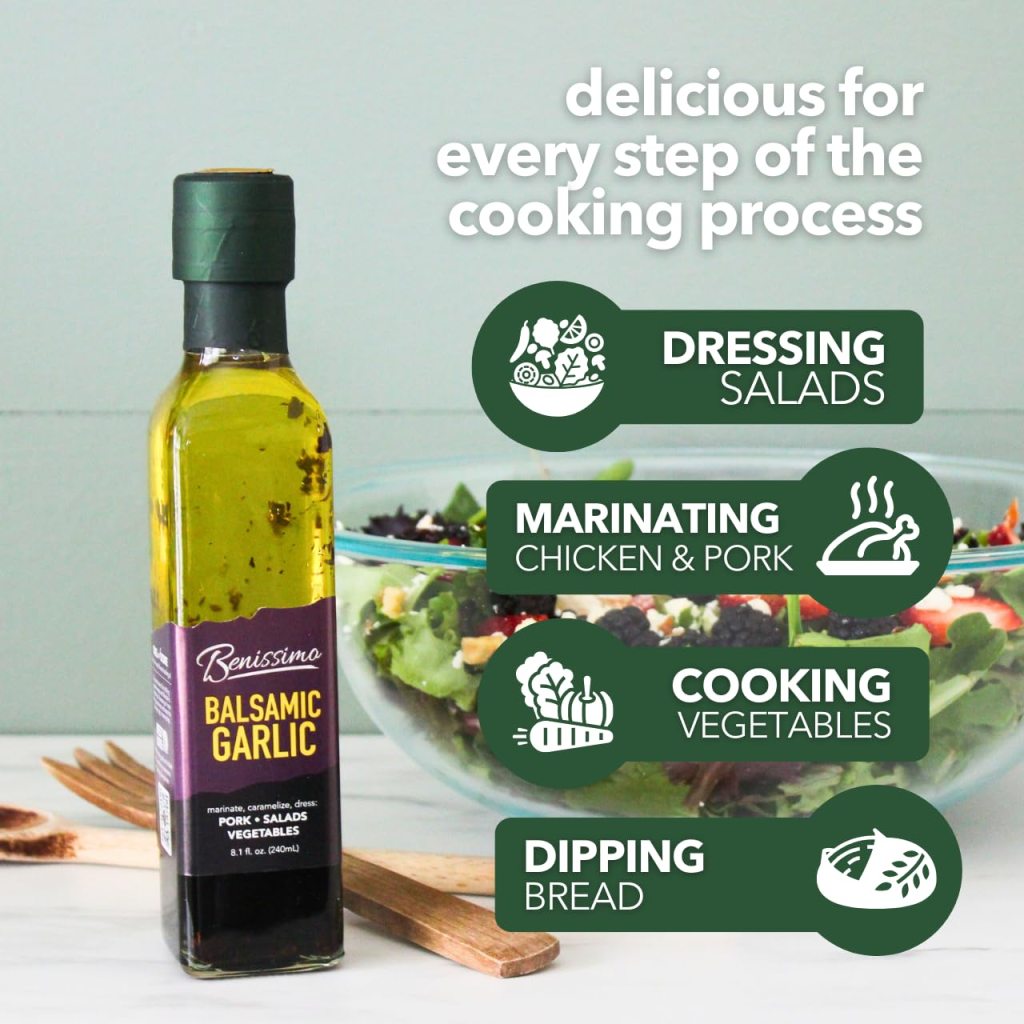A good salad is never complete without the right dressing, and nothing beats the classic simplicity of oil and vinegar salad dressing. This timeless combination has been a kitchen staple for centuries, loved for its light, tangy, and refreshing flavor. Choosing the best oil and vinegar salad dressing can transform an ordinary salad into a gourmet experience, enhancing both taste and nutrition.
Whether you’re tossing fresh greens, drizzling over roasted vegetables, or marinating grilled chicken, the right oil and vinegar dressing offers balance—bringing together richness from the oil and sharpness from the vinegar. With countless varieties on the market, from balsamic blends to herb-infused versions, it’s important to know how to pick the dressing that suits your taste and health goals.
Why Choose Oil and Vinegar Salad Dressing?
- Healthier Alternative: Compared to creamy dressings, oil and vinegar provide fewer calories and healthier fats.
- Versatility: Works with salads, marinades, sandwiches, and grilled dishes.
- Customizable Flavor: Different oils (olive, avocado, sunflower) and vinegars (balsamic, apple cider, red wine) create unique tastes.
- Nutritional Boost: Good oils supply heart-healthy fats, while vinegars aid digestion and metabolism.
Buying Guide: How to Choose the Best Oil and Vinegar Salad Dressing
When selecting the best oil and vinegar salad dressing, consider these key factors:
1. Type of Oil Used
- Extra Virgin Olive Oil (EVOO): Rich, robust flavor and packed with antioxidants.
- Avocado Oil: Light, buttery, and high in healthy monounsaturated fats.
- Sunflower or Canola Oil: Mild taste, letting vinegar dominate.
2. Type of Vinegar
- Balsamic Vinegar: Sweet, tangy, and perfect for Italian-style salads.
- Apple Cider Vinegar: Fruity, slightly sour, with added health benefits.
- Red/White Wine Vinegar: Sharp and classic, ideal for Greek or Mediterranean salads.
- Rice Vinegar: Mild and slightly sweet, common in Asian dressings.
3. Flavor Profile
- Classic Blends: Simple oil and vinegar with salt and pepper.
- Herb-Infused: Includes oregano, basil, garlic, or rosemary for added depth.
- Sweetened Varieties: With honey, maple syrup, or fruit for balance.
4. Nutritional Considerations
- Look for low sodium, no added sugars, and non-GMO or organic options if health is a priority.
- Check calorie count if you’re managing weight—oil is calorie-dense, so lighter versions may suit better.
5. Consistency and Blend
- Premium dressings should emulsify well (stay mixed) rather than separating quickly.
- Thicker dressings coat salads better, while thinner ones are great for marinades.
6. Packaging and Storage
- Dark glass bottles protect oils from light damage.
- Easy-pour spouts help with portion control.
Pro Tips for Using Oil and Vinegar Salad Dressing
- Shake the bottle well before use to ensure even distribution of flavors.
- Use sparingly—start with a tablespoon and add more if needed.
- Pair balsamic with tomatoes and mozzarella, apple cider with slaw, and red wine vinegar with Greek salads.
- Try it as a marinade for chicken, fish, or roasted vegetables for extra flavor.
Final Thoughts
The best oil and vinegar salad dressing combines quality ingredients, balanced flavor, and versatility for everyday meals. Whether you love the boldness of balsamic, the brightness of apple cider, or the sharpness of red wine vinegar, the right dressing can elevate your salads and side dishes to restaurant quality.
With the right choice, you’ll enjoy healthier meals, enhanced flavors, and a staple that fits perfectly in any kitchen.
1. Classic Balsamic Vinaigrette with Extra Virgin Olive Oil

Product Description:
A time-honored combination, this classic balsamic vinaigrette blends aged balsamic vinegar with high-quality extra virgin olive oil, garlic, Dijon mustard, and a hint of black pepper. It’s designed to drizzle over mixed greens, Caprese salad, or roasted vegetables, delivering a sweet-tart flavor profile with depth and richness.
Key Features:
- Aged balsamic vinegar base
- Extra virgin olive oil (cold pressed)
- Garlic and Dijon mustard for emulsification
- Balanced sweet-sour ratio
- Pour spout or screw cap packaging
Pros:
- Rich, well-rounded flavor that complements many salad types
- Maintains emulsion well (stays blended)
- Versatile: usable as a marinade, dressing, or drizzle
- Contains high quality EVOO with healthful fats
Cons:
- Higher price due to premium ingredients
- Some batches may lean acidic for sensitive palates
- Heavier on calories than lighter vinaigrettes
Recommendation:
If you want a go-to, high-end balsamic/olive oil blend that elevates your salads and no fuss about separating, this classic vinaigrette is a solid choice. Look for versions with minimal sugar and additives.
2. Apple Cider & Olive Oil Vinaigrette

Product Description:
This vinaigrette pairs apple cider vinegar with extra virgin olive oil, accented by a touch of honey or agave, dijon mustard, and a blend of herbs like thyme or parsley. The flavor is bright, slightly sweet, and tangy—great with slaws, grain salads, and autumn greens.
Key Features:
- Apple cider vinegar as the acid component
- Olive oil base
- A small amount of sweetener to balance acidity
- Herbs and seasoning mix
- Shakeable, lightly emulsified formula
Pros:
- Refreshing and lighter taste profile
- Works well with robust greens and vegetables
- Great for those who find balsamic too strong
- Emulsifies well with good shake
Cons:
- Sweetness may be too much for purists
- Might separate faster on very cold ingredients
- Vinegar-forward—some may find it sharp
Recommendation:
Choose this if you prefer a tangy but lighter dressing that still offers depth. Especially good in warmer months or with crisp, raw vegetables.
3. Red Wine & Shallot Vinaigrette

Product Description:
This dressing combines red wine vinegar, minced shallots, extra virgin olive oil, a touch of mustard, and pepper. It yields a savory and slightly pungent flavor, ideal for Mediterranean salads, tomatoes with herbs, or grilled veggies.
Key Features:
- Red wine vinegar
- Finely minced shallots or shallot flavoring
- Olive oil-based
- Dijon mustard or other emulsifier
- Spice and herb accents
Pros:
- Deep, savory flavor with aromatic complexity
- Great contrast on mild greens and cheeses
- Holds up in hearty salads
- Elegant, minimal ingredient profile
Cons:
- May be too strong for delicate salads
- Shallot bits can get stuck or unevenly distributed
- Separation over time—needs shaking
Recommendation:
Opt for this when you want a sophisticated flavor that’s not too sweet—especially with Mediterranean or cheese-forward salads.
4. White Wine & Tarragon Vinaigrette

Product Description:
This elegant vinaigrette uses white wine vinegar and a hint of tarragon, paired with olive oil and light seasoning. It’s delicate, herbal, and perfect for lighter salads like mixed greens, seafood dishes, or vegetable medleys.
Key Features:
- White wine vinegar
- Tarragon (fresh or dried)
- Olive oil base
- Gentle seasoning (salt, pepper)
- Light, nuanced acidity
Pros:
- Subtle, refined flavor that doesn’t overpower ingredients
- Adds herbal freshness, especially with seafood or spring salads
- Lighter on calories and acidity
Cons:
- Might be too mild for bold greens
- Separation may happen quickly
- Less forgiving in over-dressing
Recommendation:
Pick this when you want a refined, gentle dressing that complements delicate greens or dishes like grilled fish or asparagus.
5. Herb & Garlic Oil & Vinegar Dressing

Product Description:
A more assertive take on oil and vinegar, this version mixes red or white vinegar with olive oil (or a blend of oils) infused with garlic, oregano, basil, and sometimes red pepper flakes. It adds a punchy, herbaceous note to your salad.
Key Features:
- Vinegar + oil blend
- Garlic and mixed herbs (oregano, basil)
- Optional chili or pepper flakes
- Bold flavor, hearty viscosity
Pros:
- Great for bold, Mediterranean or rustic salads
- Seasoned well—less need for extra herb sprinkling
- Versatile enough for drizzling over roasted vegetables
Cons:
- May overpower more delicate salad ingredients
- Garlic bits may settle or stick
- Needs shaking before pouring
Recommendation:
Go for this when you want maximum flavor impact, especially on robust greens, tomatoes, or grilled vegetables.
6. Low-Fat Balsamic Olive Oil Blend Salad Dressing

Product Description:
This version aims to retain the classic oil-and-vinegar taste while reducing fat content. It combines balsamic vinegar, a lighter oil (or a mixture of oil and water), mustard as an emulsifier, and herbs to maintain flavor without the full oil content.
Key Features:
- Balsamic vinegar
- Lighter oil mix or partial oil substitute
- Emulsifiers (mustard, lecithin)
- Herbs and sweeteners to balance flavor
Pros:
- Lower in calories while still offering a vinaigrette feel
- Good option for diet-conscious users
- Versatile with many types of salads
Cons:
- May not provide same richness or mouthfeel as full-oil versions
- Can taste thinner or less satisfying
- Separation and consistency may be more challenging
Recommendation:
This is a good pick for those who love oil-and-vinegar dressings but want a lighter version for calorie control. Use it in everyday salads where richness is secondary.
Tips for Choosing Among These Models
- Examine ingredient lists: prefer minimal additives, no high fructose sugars, and natural oils.
- Check for emulsifiers or stabilizers that keep oil and vinegar mixed.
- Consider bottle design (spout, pour control) to avoid overuse.
- Look for dressings that match your usual salads (bold flavors vs delicate greens).
How to Wash and Clean After Using Oil and Vinegar Salad Dressing
1. Washing Utensils and Bowls
- Rinse immediately: Oil can leave a greasy residue, so rinse bowls, spoons, or shakers right after use.
- Use warm, soapy water: Dish soap cuts through oil effectively and removes vinegar odor.
- Scrub gently: A soft sponge works best; avoid abrasive pads on delicate salad bowls or bottles.
2. Cleaning Bottles or Containers
- Rinse with warm water first to loosen oil and vinegar.
- Add dish soap and hot water, shake, and rinse until all oil is gone.
- For stubborn odors (like balsamic or apple cider vinegar), add a teaspoon of baking soda, let it sit for 10–15 minutes, then wash again.
3. Washing Clothes if Spilled
- Blot immediately to absorb excess oil.
- Pre-treat with dish soap or stain remover before washing in warm water.
- Avoid hot drying until the stain is completely removed, as heat can set oil stains.
Cautions When Using Oil and Vinegar Salad Dressing
- Avoid Staining Surfaces
- Balsamic and red wine vinegar can leave dark stains on countertops, clothes, or wood. Always wipe spills quickly.
- Watch for Glass Bottle Breakage
- Many premium dressings come in glass bottles—handle carefully to avoid accidents.
- Store Properly
- Keep tightly sealed and store in a cool, dark place. Some versions with fresh herbs or garlic may need refrigeration.
- Shake Before Each Use
- Oil and vinegar naturally separate. Failing to shake can give you uneven flavor (too oily or too acidic).
- Check Expiration Dates
- Oils can turn rancid, and vinegar-based dressings can lose freshness over time. Always check before using.
- Mind Portion Size
- While healthy, oil is calorie-dense. Overusing dressing can add more calories than intended.
✨ By washing properly and using with care, your oil and vinegar salad dressing will stay fresh, safe, and delicious, while preventing stains or wasted product.
FAQs on Best Oil and Vinegar Salad Dressing
1. What makes an oil and vinegar dressing “the best”?
The best dressings use high-quality oils and vinegars, have a balanced flavor, emulsify well, and contain minimal additives or preservatives. Freshness and ingredient quality directly affect taste.
2. Can I make my own oil and vinegar salad dressing?
Yes! Combine extra virgin olive oil (or another healthy oil) with vinegar of choice, add seasonings like mustard, herbs, salt, and pepper, then whisk or shake to emulsify. Homemade versions allow full control over flavor and ingredients.
3. Which oil and vinegar combinations work best?
- Balsamic + Olive Oil: Sweet, rich, and classic.
- Apple Cider + Olive Oil: Tangy, slightly sweet, versatile.
- Red or White Wine + Olive Oil: Sharp, savory, perfect for Mediterranean-style salads.
- Rice Vinegar + Light Oil: Subtle, ideal for Asian-inspired salads.
4. Should I refrigerate oil and vinegar dressings?
- Vinegar-based dressings usually last at room temperature if sealed and unopened.
- Dressings with fresh ingredients (garlic, herbs, or shallots) should be refrigerated and used within a few weeks.
5. How do I prevent separation?
Shake or whisk before each use. Some store-bought dressings include emulsifiers to maintain a uniform texture, but shaking is always recommended.
6. Are oil and vinegar dressings healthy?
Yes. Oils like extra virgin olive oil provide heart-healthy monounsaturated fats, and vinegar may aid digestion and blood sugar regulation. Watch portion sizes to manage calories.
Conclusion
The best oil and vinegar salad dressing is all about quality, flavor, and versatility. Whether you prefer a classic balsamic blend, a tangy apple cider version, or an herb-infused specialty, choosing a high-quality dressing can elevate any salad or meal.
These dressings are not only flavorful but also provide a healthier alternative to creamy options, making them perfect for everyday meals, marinating, or entertaining. Proper storage, shaking before use, and careful application ensure you enjoy consistent taste and freshness every time.
✨ Investing in a premium oil and vinegar salad dressing—or mastering a homemade blend—adds sophistication, nutrition, and taste to your kitchen staples.

